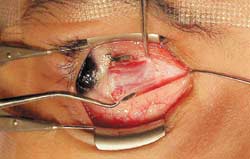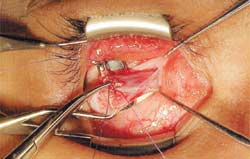Instrument advances improve strabismus surgery techniques
Pediatric strabismus comprises about 80% of cases and demands a low-risk approach.
NEWARK, N.J. -- While strabismus surgery maintains a slow evolution, a steady flow of instrumentation innovations have improved the safety and efficacy of established strabismus techniques, according to a surgeon here.
“The procedures we do are essentially standard most of the time, and involve either recessing or resecting the muscle. The innovations have come in the form of instrumentation. Over the years these tools have been constantly improving, making the techniques easier to perform,” said Rudolph S. Wagner, MD, of the Children’s Eye Care Center of New Jersey.
Most strabismus cases involve primary strabismus in pediatric patients. Only a small percentage, about 15% to 20%, represent adult acquired strabismus or trauma, according to Dr. Wagner. This provides a strong incentive for strabismus specialists to stick to standard procedures.
“Pediatric ophthalmology stays relatively stagnant because of the medicolegal ramifications. When you’re dealing with children, you don’t want to take too many risks,” explained Robert Gold, MD, of Longwood, Fla.
Instrumentation advances
Eugene Helveston, MD, of Indianapolis, has developed numerous strabismus instruments throughout his career. Most recently he designed the Helveston fixation forceps, which are manufactured by Katena Products Inc.
| |
The Helveston forceps were de-signed for fixating and retracting the globe during strabismus procedures. They have 0.6-mm 1 × 2 teeth and a thumb-activated, locking slide catch.
They feature a weighted, curved handle for stabilizing them after they are affixed to the globe. A suture may be placed through a hole in the end of the handle and attached to the drape for additional traction.
“They’re not necessary in every case, but they come in handy in certain instances. They free up the surgeon’s hand, so in the event you have to perform surgery without an assistant, or you’re doing a more complicated procedure that requires additional assistance, you can use these locking forceps,” Dr. Wagner said.
Another recent addition to the armamentarium of strabismus surgeons is the Bishop muscle hook, developed by John E. Bishop, MD, of Corpus Christi, Texas. The Bishop muscle hook is also manufactured by Katena Products.
Tight extraocular muscles are sometimes encountered during strabismus surgery. Surgical recession of a tight extraocular muscle can be difficult because of restricted globe rotation, which may not allow the optimal exposure necessary for surgery. In addition, tight muscles can indent the sclera, making needle placement into a tendon particularly dangerous. Because the sclera is often thin under extremely tight rectus muscles, the risk increases for scleral perforation during needle placement in the tendon.
The Bishop muscle hook was developed to minimize this risk. The instrument is similar to a Jameson muscle hook, with the addition of a thin stainless steel protective plate, which is hinged around the footplate. The hook is small enough to slip easily under the muscle, while the protective plate lies between the muscle belly and the sclera.
During surgery with the Bishop muscle hook, needles can be placed safely into the muscle tendon up to 3.5 mm posterior to the insertion (the posterior extent of the protective plate), according to Dr. Bishop. This 3.5-mm plate is long enough to provide adequate scleral protection for recession procedures, in which the suture is placed directly posterior to the insertion.
The instrument is particularly useful for conditions associated with tight rectus muscles, such as Duane’s syndrome, Möbius’ syndrome and congenital fibrosis syndrome.
No significant modification of standard strabismus surgical technique is required, Dr. Bishop said.
“For myself, I use it just in the difficult cases where the muscle is very tight. But I think it is a useful instrument for physicians in training who are just learning to do strabismus surgery. It gives them an extra little margin of safety,” he said.
Updated retractors, such as Dr. Helveston’s 7-mm, 9-mm and 11-mm “Barbie” retractors, are also helpful in strabismus surgery, according to Dr. Wagner.
“The advantage of these retractors is that they can very nicely retract the surrounding connective tissue or Tenon’s capsule to allow you better visualization of the operative field. These retractors and some of Dr. Helveston’s muscle hooks have had a tremendous impact on making it easier to visualize the field and do what we need to do,” Dr. Wagner said.
Locking needle holders, such as the Castroviejo straight-needle and the Barraquer curved-needle holders, are helpful as well, he said.
“The newer locking needle holders have become more suitable for using smaller spatula needles, which are less likely to penetrate deeper into the sclera when you pass your suture. With these needle holders it’s easier to control the needle and pass it satisfactorily,” he said.
For Your Information:
- Rudolph S. Wagner, MD, can be reached at Children’s Eye Care Center of New Jersey, 495 N. 13th St., Newark, NJ 07107; (973) 485-3186; fax: (973) 497-5674; e-mail: wagdoc@aol.com. Dr. Wagner has no direct financial interest in the products mentioned in this article, nor is he a paid consultant for any companies mentioned.
- Robert Gold, MD, can be reached at 515 W. State Road 434, Suite 201, Longwood, FL 32750; (407) 767-6411; fax: (407) 767-8160; e-mail: rsgeye@aol.com. Dr. Gold has no direct financial interest in the products mentioned in this article, nor is he a paid consultant for any companies mentioned.
- John E. Bishop, MD, can be reached at 4707 Everhart, Suite 108, Corpus Christi, TX 78411; (361) 857-6600; fax: (361) 855-1224. Dr. Bishop has no direct financial interest in the products mentioned in this article, nor is he a paid consultant for any companies mentioned.
- Katena Products Inc., manufacturer of the Helveston fixation forceps and the Bishop muscle hook, can be reached at 4 Stewart Court, Denville, NJ 07834; (973) 989-1600; fax: (973) 989-8175; Web site: www.katena.com.


